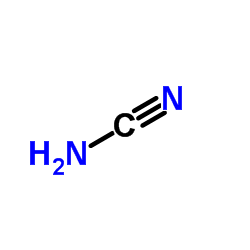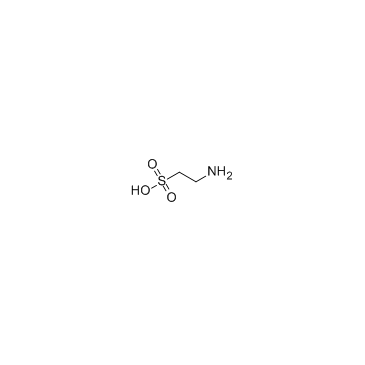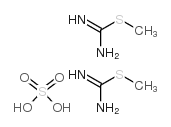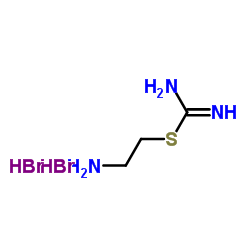Guanidinoethyl sulfonate
Modify Date: 2025-08-20 17:41:00

Guanidinoethyl sulfonate structure
|
Common Name | Guanidinoethyl sulfonate | ||
|---|---|---|---|---|
| CAS Number | 543-18-0 | Molecular Weight | 167.18700 | |
| Density | 1.73g/cm3 | Boiling Point | N/A | |
| Molecular Formula | C3H9N3O3S | Melting Point | 263-265ºC | |
| MSDS | N/A | Flash Point | N/A | |
Use of Guanidinoethyl sulfonateGuanidinoethyl sulfonate (Taurocyamine), a transport antagonist of taurine, induces much urinary taurine excretion with a resulting decrease in the tissue taurine content and readily produces taurine-deficient fetal rats in pregnant rats[1]. Guanidinoethyl sulfonate, a structural analogue of taurine, acts as a competitive inhibitor of taurine transport[2]. |
| Name | taurocyamine |
|---|---|
| Synonym | More Synonyms |
| Description | Guanidinoethyl sulfonate (Taurocyamine), a transport antagonist of taurine, induces much urinary taurine excretion with a resulting decrease in the tissue taurine content and readily produces taurine-deficient fetal rats in pregnant rats[1]. Guanidinoethyl sulfonate, a structural analogue of taurine, acts as a competitive inhibitor of taurine transport[2]. |
|---|---|
| Related Catalog | |
| Target |
Human Endogenous Metabolite |
| References |
| Density | 1.73g/cm3 |
|---|---|
| Melting Point | 263-265ºC |
| Molecular Formula | C3H9N3O3S |
| Molecular Weight | 167.18700 |
| Exact Mass | 167.03600 |
| PSA | 124.65000 |
| LogP | 0.62900 |
| Index of Refraction | 1.618 |
| InChIKey | JKLRIMRKZBSSED-UHFFFAOYSA-N |
| SMILES | NC(N)=NCCS(=O)(=O)O |
Synonym:N-Amidinotaurin Section 2 - COMPOSITION, INFORMATION ON INGREDIENTS
Risk Phrases: 34 Section 3 - HAZARDS IDENTIFICATION EMERGENCY OVERVIEW
Causes burns. Potential Health Effects Eye: Causes eye burns. Skin: Causes skin burns. Ingestion: Causes gastrointestinal tract burns. Inhalation: Causes chemical burns to the respiratory tract. Chronic: Not available. Section 4 - FIRST AID MEASURES Eyes: Immediately flush eyes with plenty of water for at least 15 minutes, occasionally lifting the upper and lower eyelids. Get medical aid immediately. Skin: Get medical aid immediately. Immediately flush skin with plenty of water for at least 15 minutes while removing contaminated clothing and shoes. Ingestion: Do not induce vomiting. Get medical aid immediately. Inhalation: Get medical aid immediately. Remove from exposure and move to fresh air immediately. If not breathing, give artificial respiration. If breathing is difficult, give oxygen. Notes to Physician: Treat symptomatically and supportively. Section 5 - FIRE FIGHTING MEASURES General Information: As in any fire, wear a self-contained breathing apparatus in pressure-demand, MSHA/NIOSH (approved or equivalent), and full protective gear. Extinguishing Media: Use foam, dry chemical, or carbon dioxide. Section 6 - ACCIDENTAL RELEASE MEASURES General Information: Use proper personal protective equipment as indicated in Section 8. Spills/Leaks: Absorb spill with inert material (e.g. vermiculite, sand or earth), then place in suitable container. Vacuum or sweep up material and place into a suitable disposal container. Section 7 - HANDLING and STORAGE Handling: Do not breathe dust, vapor, mist, or gas. Do not get in eyes, on skin, or on clothing. Use only in a chemical fume hood. Storage: Store in a cool, dry place. Store in a tightly closed container. Corrosives area. Section 8 - EXPOSURE CONTROLS, PERSONAL PROTECTION Engineering Controls: Facilities storing or utilizing this material should be equipped with an eyewash facility and a safety shower. Use adequate ventilation to keep airborne concentrations low. Exposure Limits CAS# 543-18-0: Personal Protective Equipment Eyes: Not available. Skin: Wear appropriate protective gloves to prevent skin exposure. Clothing: Wear appropriate protective clothing to prevent skin exposure. Respirators: Follow the OSHA respirator regulations found in 29 CFR 1910.134 or European Standard EN 149. Use a NIOSH/MSHA or European Standard EN 149 approved respirator if exposure limits are exceeded or if irritation or other symptoms are experienced. Section 9 - PHYSICAL AND CHEMICAL PROPERTIES Physical State: Solid Color: white Odor: Not available. pH: Not available. Vapor Pressure: Not available. Viscosity: Not available. Boiling Point: Not available. Freezing/Melting Point: 263 - 265 deg C Autoignition Temperature: Not available. Flash Point: Not available. Explosion Limits, lower: Not available. Explosion Limits, upper: Not available. Decomposition Temperature: Solubility in water: Specific Gravity/Density: Molecular Formula: C3H9N3O3S Molecular Weight: 167 Section 10 - STABILITY AND REACTIVITY Chemical Stability: Not available. Conditions to Avoid: Incompatible materials. Incompatibilities with Other Materials: Oxidizing agents. Hazardous Decomposition Products: Nitrogen oxides, carbon monoxide, oxides of sulfur, carbon dioxide. Hazardous Polymerization: Has not been reported Section 11 - TOXICOLOGICAL INFORMATION RTECS#: CAS# 543-18-0 unlisted. LD50/LC50: Not available. Carcinogenicity: 2-{[Amino(imino)methyl]amino}ethane-1-sulfonic acid - Not listed by ACGIH, IARC, or NTP. Section 12 - ECOLOGICAL INFORMATION Section 13 - DISPOSAL CONSIDERATIONS Dispose of in a manner consistent with federal, state, and local regulations. Section 14 - TRANSPORT INFORMATION IATA Shipping Name: CORROSIVE SOLID, N.O.S.* Hazard Class: 8 UN Number: 1759 Packing Group: III IMO Shipping Name: CORROSIVE SOLID, N.O.S. Hazard Class: 8 UN Number: 1759 Packing Group: III RID/ADR Shipping Name: CORROSIVE SOLID, N.O.S. Hazard Class: 8 UN Number: 1759 Packing group: III Section 15 - REGULATORY INFORMATION European/International Regulations European Labeling in Accordance with EC Directives Hazard Symbols: C Risk Phrases: R 34 Causes burns. Safety Phrases: S 26 In case of contact with eyes, rinse immediately with plenty of water and seek medical advice. S 36/37/39 Wear suitable protective clothing, gloves and eye/face protection. S 45 In case of accident or if you feel unwell, seek medical advice immediately (show the label where possible). WGK (Water Danger/Protection) CAS# 543-18-0: No information available. Canada None of the chemicals in this product are listed on the DSL/NDSL list. CAS# 543-18-0 is not listed on Canada's Ingredient Disclosure List. US FEDERAL TSCA CAS# 543-18-0 is not listed on the TSCA inventory. It is for research and development use only. SECTION 16 - ADDITIONAL INFORMATION N/A |
| Risk Phrases | 34 |
|---|---|
| Safety Phrases | S26-S36-S37-S39 |
| RIDADR | UN 3261 |
| HS Code | 2925290090 |
| HS Code | 2925290090 |
|---|---|
| Summary | 2925290090 other imines and their derivatives; salts thereof。Supervision conditions:None。VAT:17.0%。Tax rebate rate:9.0%。MFN tariff:6.5%。General tariff:30.0% |
| Guanidinoethyl Sulfonate |
| 2-(diaminomethylideneamino)ethanesulfonic acid |
 CAS#:420-04-2
CAS#:420-04-2 CAS#:107-35-7
CAS#:107-35-7 CAS#:22722-03-8
CAS#:22722-03-8 CAS#:2986-19-8
CAS#:2986-19-8 CAS#:56-10-0
CAS#:56-10-0 CAS#:124-38-9
CAS#:124-38-9 CAS#:7664-41-7
CAS#:7664-41-7 CAS#:4189-99-5
CAS#:4189-99-5